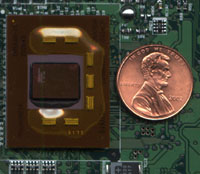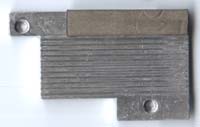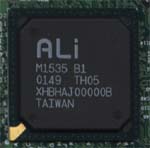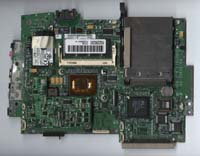PaceBook PaceBlade: The Tablet PC Arrives
by Matthew Witheiler on May 17, 2002 12:00 PM EST- Posted in
- Laptops
Construction - Under the Hood
Behind the PaceBook's magnesium shell lives some interesting hardware including a 600MHz Transmeta Crusoe processor, 256MB of memory, a Lynx3DM video chip, and a 20GB hard drive.
The PaceBook was refreshingly easy to disassemble. With the removal of quite a few screws, the back panel on the system just lifted off, providing a view of many of the system's vital components. Perhaps the most prominent item on the back of the PaceBook's motherboard is the Transmeta Crusoe TM5600 600MHz CPU.
Transmeta earned a name for themselves a few years back with the announcement of the Transmeta CPU which promised to provide high performance computing with low power consumption. The x86 compatible processor was to combine hardware and "code morphing" software to allow the VLIW (Very Long Instruction Word) Crusoe to understand x86 commands. The benefits: a smaller CPU package that consumed up to 70 percent less power than competing chips.
Transmeta CPUs have been used in portable computers for some time now and are the processor of choice for ultra-portable systems because of their low power consumption. We will have to wait until we get to the benchmarks before we see what is compromised for the low power consumption.
The flip-chip Crusoe TM5600 is mounted directly on the PaceBook's motherboard and is not available in a socketed configuration. As you may recall, the Crusoe TM5600 includes 64K of 8-way set associative L1 instruction cache, 64K of 16-way set associative L1 data cache, and 512K of 4-way set associative write back L2 cache. The chip also includes an integrated northbridge, providing DDR or SDR SDRAM support as well as a PCI controller and a southbridge interface.
PaceBlade currently has PaceBook systems running on new Crusoe TM5800 chips and the company hopes to bring PaceBooks with speed up to 1.0GHz to market soon.
As you may have noticed when we took a look around the PaceBook system, the PaceBook has no holes or openings of any sorts. PaceBlade lists this as a feature, as it prevents dust from getting inside the system, but at the same time it means that no air is getting into or out of the system. Cooling for the Crusoe processor is provided by a passive heatsink with fairly few fins on it. The CPU core is not bonded to the heatsink: instead the core sits in a small indentation on the heatsink's surface. As a result of the passive cooling method in a sealed case, the PaceBook gets quite toasty under stressful use. We were able to get our PaceBook up to 118.5 degrees Fahrenheit (48.1 degrees Celsius). This extreme temperature was not limited to only one area of the system: the whole left side of the system, top, bottom, and side, consistently measured well above 100 degrees Fahrenheit (37.8 degrees Celsius).
For a southbridge, PaceBlade turned to ALi who supplied them with the M1535 southbridge. The southbridge offers ATA/66 support as well as an integrated software modem, software sound, and integrated super I/O interface.
Located to the right of the ALi southbridge are two Mitsubishi ROM chips that the CPU uses to store the code morphing software.
The other items present on the back of the PaceBook's motherboard are the system memory and expansion memory, the modem card (to the left of the memory) and the PCMCIA connection.















1 Comments
View All Comments
Dr AB - Monday, May 11, 2020 - link
That was huge and bulky. Didnt even stood a chance to be successful.